Apple Magic Keyboard for iPad Pro review: Finally, a good iPad keyboard
- 08 May, 2020 20:15

Apple’s keyboard cases for the iPad tend to emphasize protection. The keyboard itself often feels like an afterthought. Even in the best cases, it comes off as a grudging concession to those of us who really don’t want to use the digital keyboard for long typing sessions.
But Apple’s new Magic Keyboard for iPad Pro is the first one that actually feels as though you were meant to work on it. The backlit keys have great key travel, and they’re wide enough to recall the ones you’ll find on a MacBook. These features would have been impressive on their own, but Apple went a step further and included a trackpad and a dedicated charging port that greatly enriches the experience.
Taken together, these are signs that Apple is not only changing its ideas of what constitutes a good iPad keyboard case, but also in how the views the purpose fo the iPad itself. For those of us who want to use Apple’s tablet in a workplace setting, that’s good news—although, as we’ll see, it comes with a hefty price.
As with the Smart Keyboard Folio before it, "installing" the Magic Keyboard case involves nothing more than slapping the iPad Pro on the strong magnets inside the case. It pairs instantly just by touching the Smart Connector, so—unlike with a Bluetooth keyboard—you can already use it when you’re, say, entering your Wi-Fi password while setting up a brand-new iPad Pro.
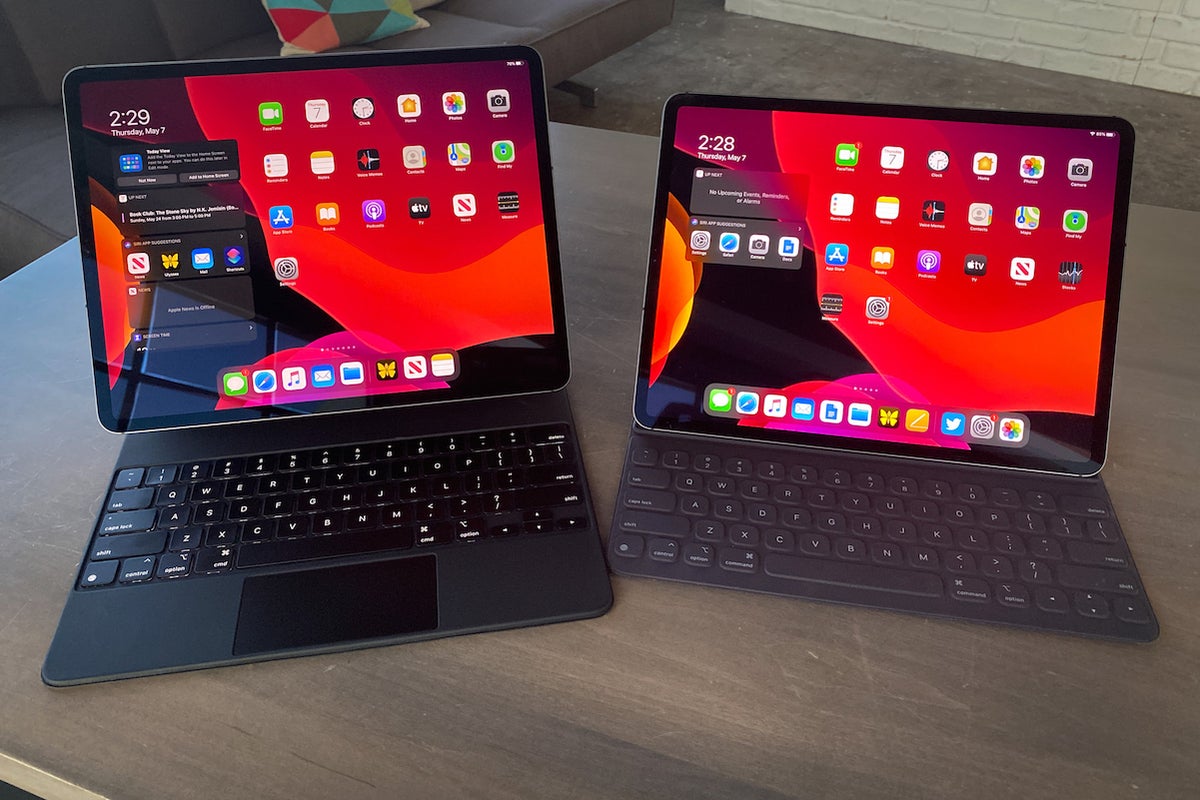 Leif Johnson/IDG
Leif Johnson/IDG
The Magic Keyboard case (left) next to the Smart Keyboard Folio. Both tablets are 12.9-inch iPad Pros.
The real improvements, though, appear once you open the case all the way. With the Smart Keyboard Folio, you simply propped the iPad into one of two grooves, which didn’t allow for a lot of options for viewing angles. The Magic Keyboard, though, features a system of two hinges that makes the iPad "float" about an inch above the keyboard, allowing you to tilt the screen until it settles into the perfect viewing angle. It’s quite sturdy
Apple released an ad depicting a hummingbird tilting the display backward just by tapping it, but in my experience it’s going to take a bit more force than that. I’d go so far as to say that I like this kind of display arrangement more than the traditional layout option, were it not for the fact that my fingers sometimes bump into the underside of the iPad while I’m typing. If you have big hands, it’s something you’ll want to watch out for.
Nor does Apple limit the hinge to one job, as you can also charge the iPad itself through the USB-C/Thunderbolt 3 port on the left end of the largest one. You can’t use this port for anything else, but fortunately it frees up the USB-C port on the tablet itself so you can hook up all the external drives, cameras, and other devices now supported with iPadOS.
 Leif Johnson/IDG
Leif Johnson/IDG
I like how you'd barely know the passthrough charging port was there unless you were looking for it.
This is all great news for anyone who’s been wanting to use their iPad Pro more like a laptop. It’s not an ideal case, though, if you’re an artist or frequent Apple Pencil notetaker. Because of the hinges and the need for balance, the Magic Keyboard case only opens to a specific angle, as the other hinge handles the actual tilting. As a result, there’s technically no "drawing board" orientation for this case, although you can find a few examples of users sort of making it work online. It looks dorky, to be sure, but at least it’s an option. At the very least, you can easily take it out the case.
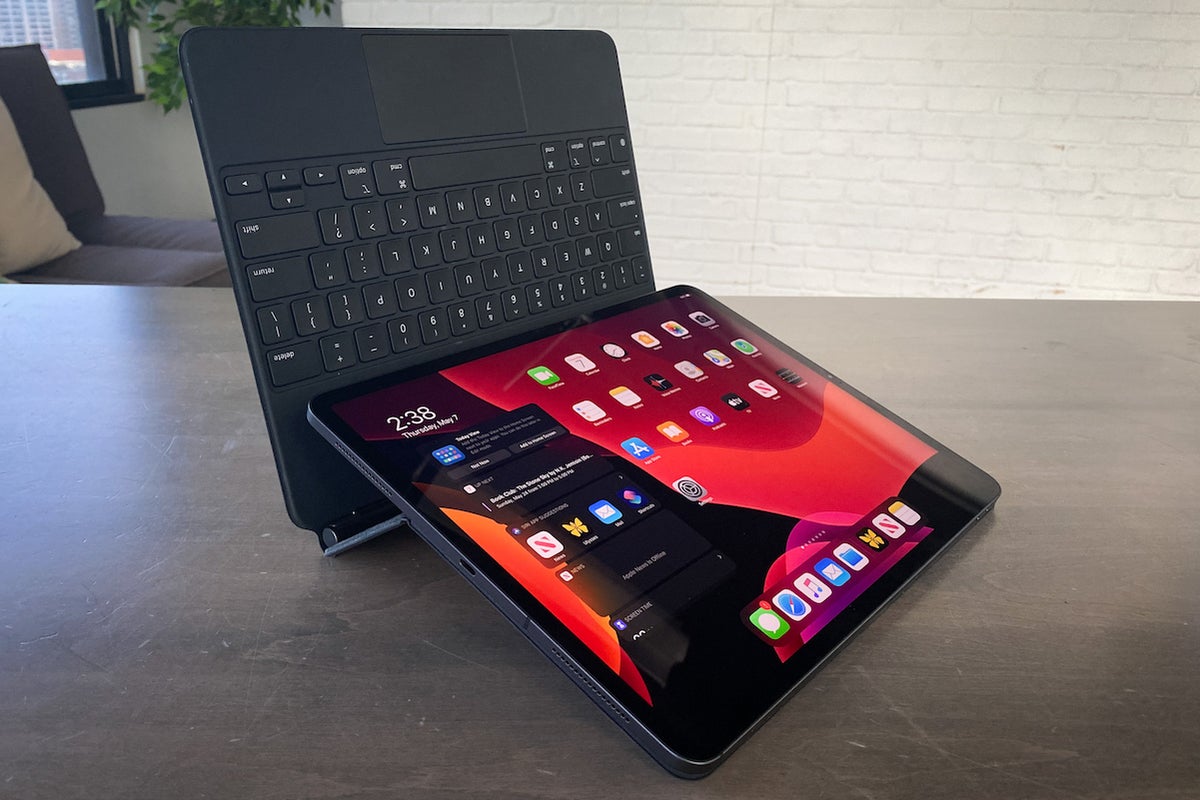 Leif Johnson/IDG
Leif Johnson/IDG
See? Dorky. This isn't really all that feasible, either, since the hinge starts moving with only a slight bit of pressure.
Keys to success
But most people are more likely to be excited by the keyboard itself—aside, that is, from the lack of any kind of "function" keys above the number keys. Such keys are all but standard on most third-party iPad keyboards as they’re handy for dimming the backlit keys (which is a massive pain here that involves a trip into the Settings app), and it’s odd to see this extra row missing on a device from the same company that gave us the Touch Bar. I would have imagined that if any company would understand the conveniences of that extra row, it’d be Apple.
The actual keys go a long way toward making up for it. They’re big, backlit, and they feel a lot like the keys on a MacBook, which is a welcome switch from the strange, nearly flat canvas-covered keys on the iPad Pro. Without exaggeration, it’s the best typing experience I’ve ever experienced on an iPad keyboard from Apple—or any other company, for that matter. I like it so much that I find myself wishing Apple’s normal, standalone Bluetooth Magic Keyboard was a bit more like this.
The real star of the Magic Keyboard is the small, two by four-inch clickable trackpad perched below the keyboard, which greatly improves the experience of using an iPad in its "laptop" orientation. Want to head back to the home screen at any time? Just swipe up with your three of your fingers and you’re done. Want to scroll through all of your apps from the home screen? Swipe left or right with two of your fingertips. I was even surprised that pressing the trackpad brings up the notifications menu, and after a couple of days I already miss that option when I got back to my Mac.
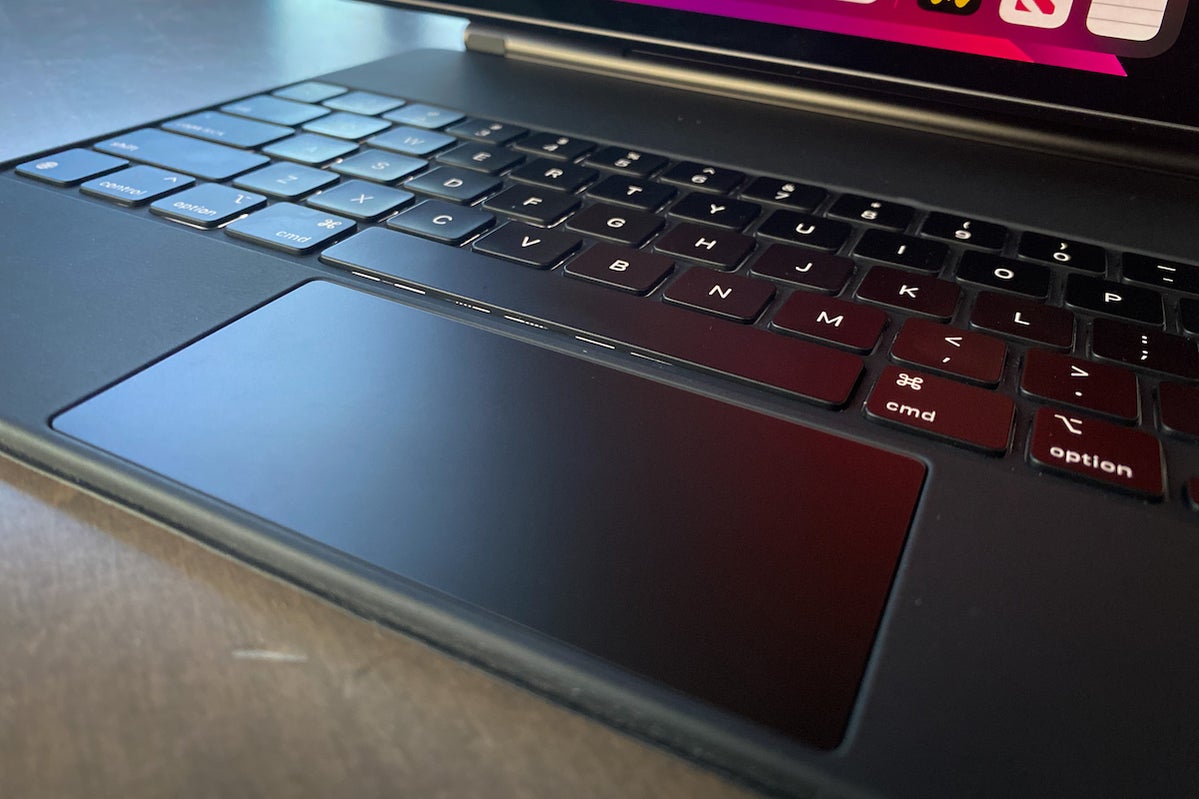 Leif Johnson/IDG
Leif Johnson/IDG
It's beautifully responsive, too.
Because a trackpad so neatly allows for the recreation of many of iPadOS’s core gestures, I already find it more useful than I do on my Mac. (This may be controversial, but I also prefer the smaller size of the Magic Keyboard trackpad.) Most surprisingly at all, it works so well that I haven’t felt the urge to hook up a mouse. Its chief appeal lies in the way it removes the need to keep reaching up to poke the iPad screen in the middle of a task, as you can now perform a similar gesture without worrying about moving your hands too far from a typing position. Over time, the seconds you save become minutes. It’s also simply less distracting when you’re zoned in on your work.
The Magic Keyboard is beautifully designed for a keyboard case. And if it cost about $50 less than it does right now, then I’d be telling everyone to go and get it right now. But even considering its USB-C port, even considering its grippy and sufficiently tough exterior, the Magic Keyboard is still basically just a keyboard with a trackpad. The presentation might be innovative, but the individual parts are nothing new.
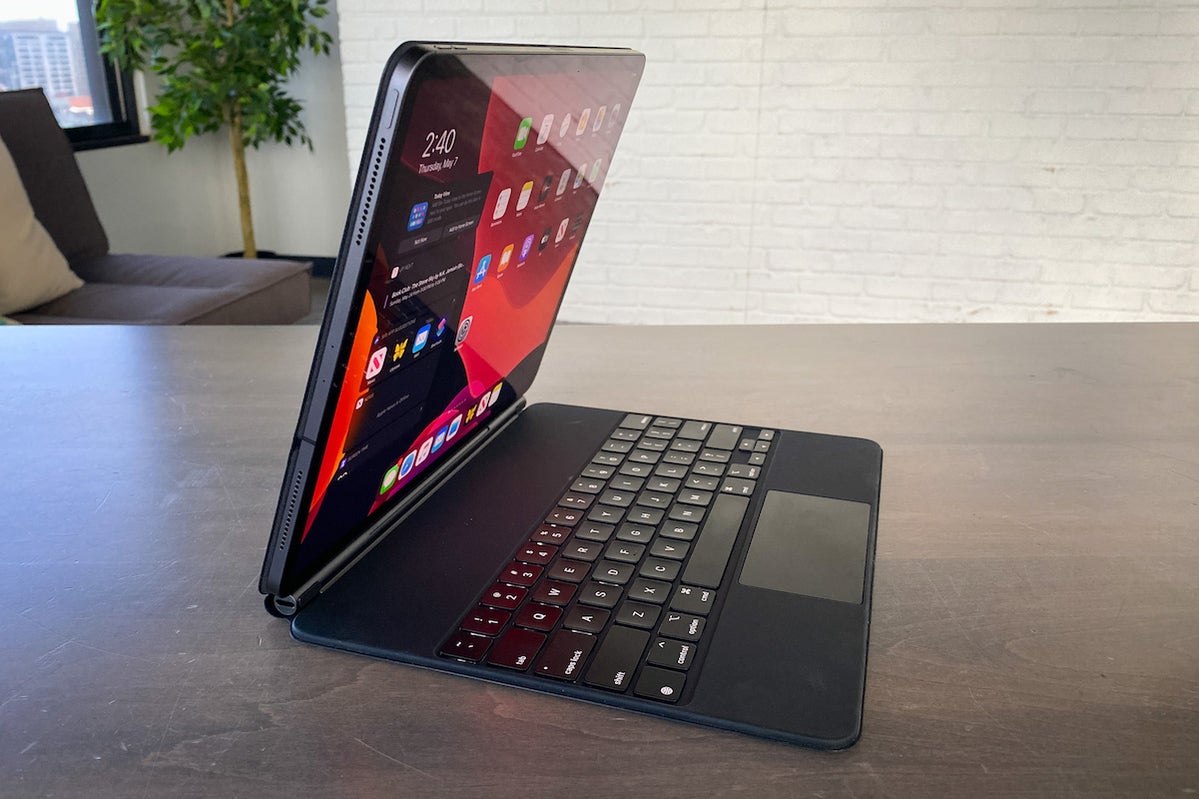 Leif Johnson/IDG
Leif Johnson/IDG
Just to be clear, this is as far as the Magic Keyboard opens if you don't move the second hinge. In other words, you won't be flipping the keyboard behind the iPad with this model.
And that’s why it’s hard to stomach the fact that Apple is charging $349 for the 12.9-inch model I’m using, and $299 for the smaller 11-inch model. To put that price in some perspective, Apple’s baseline but capable 10.2-inch iPad starts at $329. Yes, if that didn’t click, this keyboard case costs more than an iPad. And once you saddle this thing on the least-expensive 12.9-inch iPad Pro, you’re looking at a minimum price of $1,349. For more perspective, you could buy a 512GB MacBook Air and it’d still cost less money. The catch, of course, if that you can’t just take off the keyboard on a MacBook Air. That’s possible here.
Then there are other considerations to keep in mind, too. With the iPad Pro attached, it weighs a whopping three pounds, for one thing. It’s good for protection, but only to an extent—as with the Smart Folio Keyboard, there’s no protection around the edges, so too bad if your iPad Pro plummets to the cement on its side. On the bright side, I do like that it’s still compatible with the 2018 iPad Pro. The Magic Keyboard paired fine with that unit, and the only real downside is the slightly larger hole for the camera array since the 2018 model had a smaller lens.
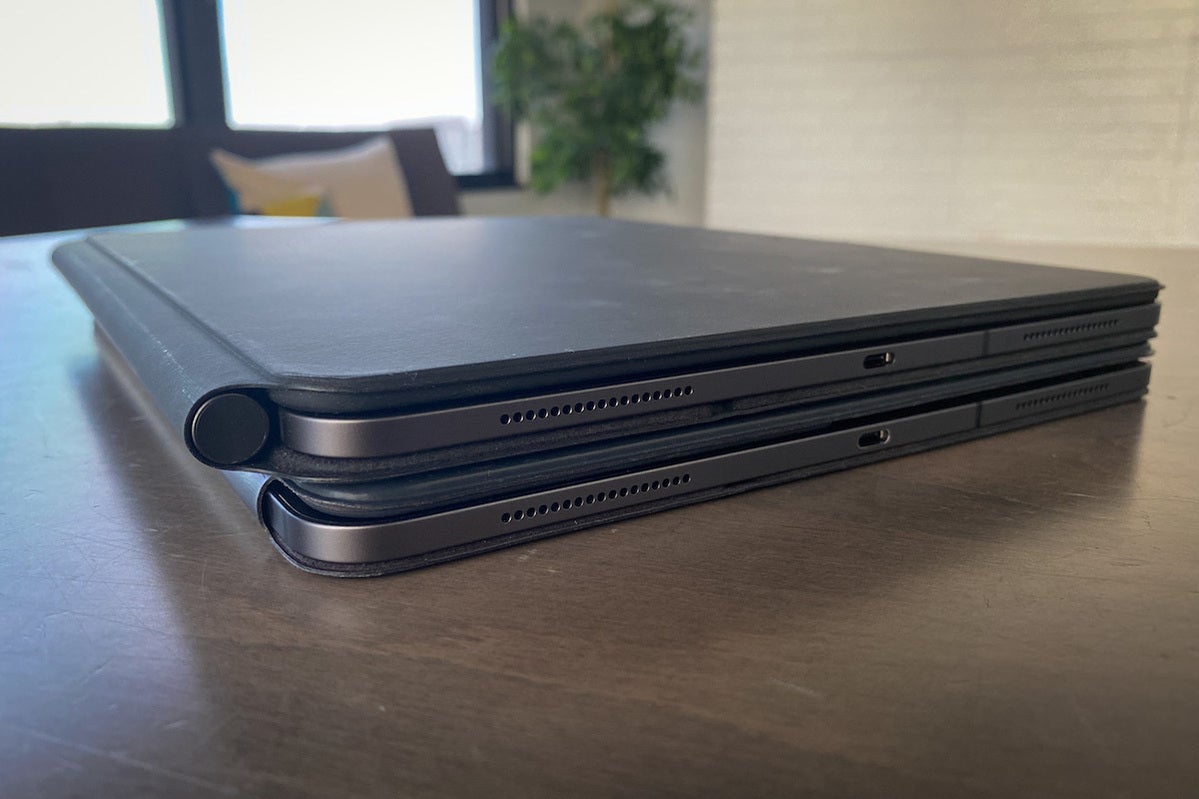 Leif Johnson/IDG
Leif Johnson/IDG
The Magic Keyboard on top of the Smart Keyboard Folio. You won't notice much difference in thickness, but the Magic Keyboard is considerably heavier because of the hinge.
Bottom line
The Magic Keyboard for iPad Pro is the best keyboard case for the iPad that Apple has made to date. Its backlit keys make typing feel more fun than forced, and its adjustable display makes it easier to find a comfortable viewing angle—so long, that is, as you don’t want it tilted too far back. Already after a few days I find it really hard to recommend the Smart Folio Keyboard in place of this.
The only real exceptions I can think of are if you’re an artist or if you work in a gritty environment where sand and other particles could slip under the keys—but in that case, you probably shouldn’t be carrying a tablet as expensive as the iPad Pro there in the first place.





